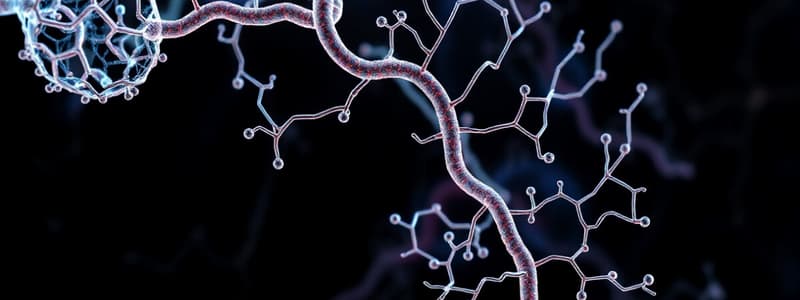Podcast
Questions and Answers
What is the primary function of glycolysis?
What is the primary function of glycolysis?
- Conversion of glucose to pyruvate (correct)
- Conversion of pyruvate to glucose
- Production of ATP from fat
- Synthesis of amino acids
Which enzyme is NOT considered a regulatory site in glycolysis?
Which enzyme is NOT considered a regulatory site in glycolysis?
- Lactate dehydrogenase (correct)
- Phosphofructokinase
- Hexokinase
- Pyruvate kinase
During glycolysis, how many ATP molecules are produced from a single glucose molecule?
During glycolysis, how many ATP molecules are produced from a single glucose molecule?
- 2 ATP
- 6 ATP
- 4 ATP (correct)
- 8 ATP
What inhibits the enzyme phosphofructokinase (PFK) in glycolysis?
What inhibits the enzyme phosphofructokinase (PFK) in glycolysis?
Which of the following correctly represents the overall reaction of glycolysis?
Which of the following correctly represents the overall reaction of glycolysis?
What represents the irreversible step in glycolysis?
What represents the irreversible step in glycolysis?
How many NADH molecules are generated during glycolysis from one glucose molecule?
How many NADH molecules are generated during glycolysis from one glucose molecule?
Which of the following compounds is an important intermediate and node during glycolysis?
Which of the following compounds is an important intermediate and node during glycolysis?
Flashcards
Glycolysis
Glycolysis
The process of converting glucose into pyruvate, generating ATP and reducing equivalents (NADH). This is the first stage of cellular respiration, occurring in the cytoplasm.
Gluconeogenesis
Gluconeogenesis
The process of synthesizing glucose from non-carbohydrate precursors, such as pyruvate, lactate, or glycerol. It is the reverse of glycolysis.
Glucose phosphorylation
Glucose phosphorylation
The first step in glycolysis where glucose is phosphorylated by hexokinase using ATP to produce Glucose-6-Phosphate (G6P). This is an irreversible step.
PFK (Phosphofructokinase) reaction
PFK (Phosphofructokinase) reaction
Signup and view all the flashcards
Hexokinase
Hexokinase
Signup and view all the flashcards
Phosphofructokinase (PFK)
Phosphofructokinase (PFK)
Signup and view all the flashcards
Pyruvate Kinase reaction
Pyruvate Kinase reaction
Signup and view all the flashcards
Fermentation
Fermentation
Signup and view all the flashcards
Study Notes
Glycolysis Overview
- Glycolysis converts glucose to pyruvate
- Gluconeogenesis converts pyruvate back to glucose
- Glycolysis is a 10-step process
- Glycolysis generates energy (ATP and NADH)
- Glycolysis has two phases: preparatory and ATP-generating
- Glycolysis is tightly regulated to maintain energy balance
Glycolysis: Counting Electrons
- Glycolysis involves the transfer of electrons to NAD+ to generate NADH
- Glucose is oxidized to pyruvate
- 2x (C3-, C2+, C3+) = C2+
- 10-step process
Glycolysis: Counting Phosphates
- Glycolysis involves a series of phosphorylation reactions
- Two ATP are initially consumed
- A total of four ATP molecules are generated
- Net gain of 2 ATP molecules
Glycolysis: Two Parts
- Phase 1 (preparatory phase) consumes 2 ATP, and results in glucose breaking down into two 3-carbon molecules
- Phase 2 (ATP-generating phase) generates 4 ATP and occurs in the cytosol
- The overall yield of Glycolysis is 2 ATP and 2 NADH per glucose molecule
- Carbon & electrons are accounted for but the location of phosphate is not, thus, a concern in this step of Glycolysis
Glycolysis: Better Representation
- A detailed diagram outlining glycolysis steps & key components
- Phosphorylation, isomerization, cleavage, and phosphorylation are indicated as key features of glycolysis
"Pumps" of Glycolysis: Sites of Regulation
- A table summarizing reactions of Glycolysis
- Names of each reaction and steps, along with detailed enzyme that catalyzes that reaction
- Key regulatory steps of Glycolysis are highlighted (e.g., Hexokinase, Phosphofructokinase, Pyruvate Kinase)
- The table shows the equilibrium constant and the changing conditions as the reaction proceeds
G6P: Important Node
- Glucose 6-phosphate (G6P) is a crucial intermediate molecule
- G6P is a central crossroads in metabolism
- G6P leads to other pathways
- G6P has many different paths it can take depending on the body's needs
PFK First Committed Step
- PFK (Phosphofructokinase-1) is the first committed step in glycolysis
- PFK catalyzes the irreversible conversion of fructose-6-phosphate to fructose-1,6-bisphosphate
- This step is key to regulating glycolysis.
Glycolysis Makes ATP: ATP Inhibits Pump PFK
- Glycolysis yields ATP
- ATP is an allosteric regulator that inhibits PFK
- AMP activates PFK
- Fructose 2,6-bis-P is a stimulator for PFK
PFK Regulated by Energy Need: AMP & ATP
- AMP and ATP are important regulators of PFK
- High AMP indicates low energy levels, thus, PFK is needed to regenerate ATP
- High ATP indicates enough energy and PFK should be inhibited
- PFK activity regulated by AMP and ATP, as well as fructose-2,6-bisphosphate.
Okay, what do I need to know?
- Overall pathway, significant nodes (e.g., G6P, pyruvate)
- Principles of electron and phosphate counting
- Details & meaning of key regulatory steps, such as the "pumps".
- Activation and inhibition logic for key enzymes.
Studying That Suits You
Use AI to generate personalized quizzes and flashcards to suit your learning preferences.




